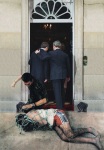Well, well, well, look who it is…
You certainly seem to know more about what you’re doing now don’t you! You’ve made quite a collection of new mates and appear to have settled in well with your course.
I used to agree with you, this letter to self task seemed quite odd at first, however, having read what I/you wrote at the beginning of the year, it’s proven significantly useful in seeing how me and you have developed as a person. You’ve done well in producing some interesting and worth-while work.
You have definitely become more aware of what is expected of you throughout the course of your modules and have adapted well with the equipment that has been introduced to you. You have met interesting and inspirational people within the media industry, including famous writers, producers, journalists and directors and have been given advice from them of how to go about your work.
You have been introduced to a variety of new programmes, including editing software, such as AVID and FinalCutPro meaning you have been able to produce some more advanced films. You have learnt a vast amount in your first year, but as the media industry is always changing, there is still much to learn yet. The things you have learnt and will learn will be not only down to your tutors, but also you.
This year you were introduced to studio work and television broadcasting. This has had a huge impact in terms of inspiring you to follow your dream of having an influential role in a television comedy series. Strangely, you have enjoyed being in front of the camera more than being behind it. This is something we must work on… to see if you are actually going down the right path!?
Lastly, you have become more confident this year, particularly when talking to people you have never met before; you are no longer worried about what other people think of you and tend to do your own thing in these situations.
Let’s see what next year has in store for you!
All the best,
You










